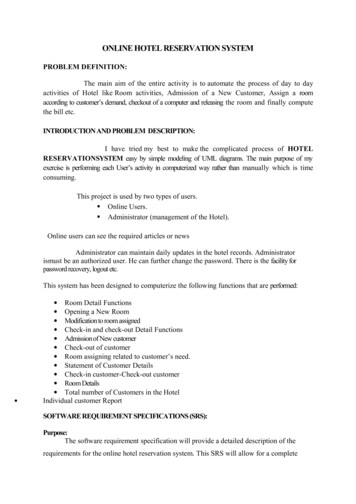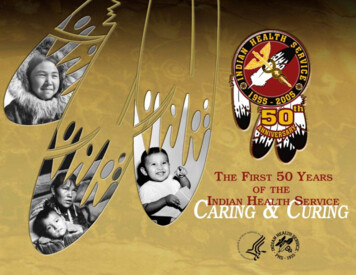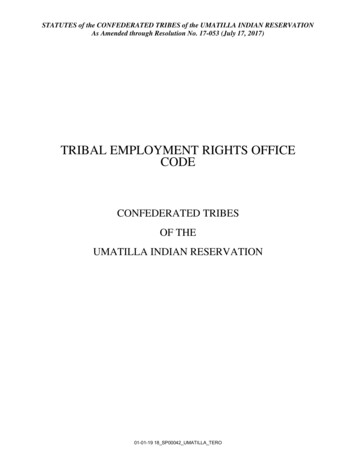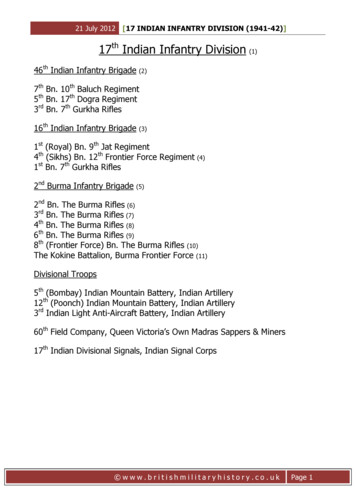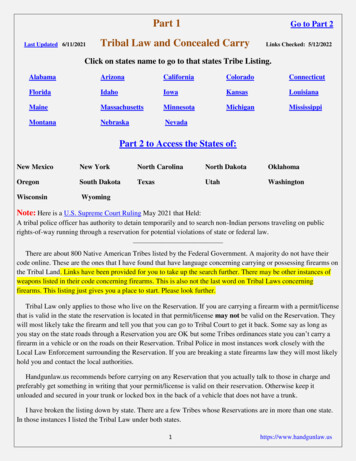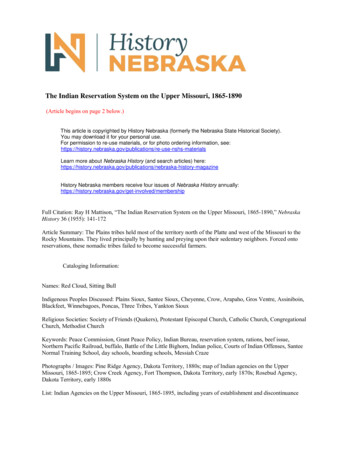
Transcription
The Indian Reservation System on the Upper Missouri, 1865-1890(Article begins on page 2 below.)This article is copyrighted by History Nebraska (formerly the Nebraska State Historical Society).You may download it for your personal use.For permission to re-use materials, or for photo ordering information, se-nshs-materialsLearn more about Nebraska History (and search articles) raska-history-magazineHistory Nebraska members receive four issues of Nebraska History /membershipFull Citation: Ray H Mattison, “The Indian Reservation System on the Upper Missouri, 1865-1890,” NebraskaHistory 36 (1955): 141-172Article Summary: The Plains tribes held most of the territory north of the Platte and west of the Missouri to theRocky Mountains. They lived principally by hunting and preying upon their sedentary neighbors. Forced ontoreservations, these nomadic tribes failed to become successful farmers.Cataloging Information:Names: Red Cloud, Sitting BullIndigenous Peoples Discussed: Plains Sioux, Santee Sioux, Cheyenne, Crow, Arapaho, Gros Ventre, Assiniboin,Blackfeet, Winnebagoes, Poncas, Three Tribes, Yankton SiouxReligious Societies: Society of Friends (Quakers), Protestant Episcopal Church, Catholic Church, CongregationalChurch, Methodist ChurchKeywords: Peace Commission, Grant Peace Policy, Indian Bureau, reservation system, rations, beef issue,Northern Pacific Railroad, buffalo, Battle of the Little Bighorn, Indian police, Courts of Indian Offenses, SanteeNormal Training School, day schools, boarding schools, Messiah CrazePhotographs / Images: Pine Ridge Agency, Dakota Territory, 1880s; map of Indian agencies on the UpperMissouri, 1865-1895; Crow Creek Agency, Fort Thompson, Dakota Territory, early 1870s; Rosebud Agency,Dakota Territory, early 1880sList: Indian Agencies on the Upper Missouri, 1865-1895, including years of establishment and discontinuance
THE INDIAN RESERVATION SYSTEM ON THEUPPER MISSOURI. 1865-1890BY RAY H. MATTISONo the intelligent observer passing up the Missouri fromOmaha to Fort Benton in the summer of 1865, thecontrasts in the patterns of Indian life must have beenvery interesting. Between Omaha and Fort Randall werethe reservations of the Omaha, Winnebago, Ponca, and theYankton Sioux. These Indians were primarily agriculturaland sedentary in character although they depended partlyon game for their livelihood. They had reluctantly acceptedthe futility of opposing the advance of the whites and hadreconciled themselves to reservation life. At Fort Thompson, some 110 miles above Fort Randall, was the concentration camp of the Santee Sioux. These people, now prisonersof war, had been rounded up following their uprising inMinnesota three years before and would soon be shippedto their new reservation in Nebraska below the Niobrara.Adjacent to the trading post of Fort Berthold at Like-aFishhook Village in present North Dakota were the ThreeTribes. These semi-agricultural bands, greatly reduced innumber from smallpox, had joined together to protectthemselves against the Sioux. Otherwise, with the exception of the eastern half of Nebraska, the Plains tribes heldmost of the territory north of the Platte and west of theMissouri to the Rocky Mountains. 1TlCharles C. Royce, comp., "Indian Land Cessions in the UnitedStates," Eighteenth AnnuaL Report of the Bureau of AmericanEthnoLogy (Washington, 1899), Part II, passim.Ray H. Mattison, a frequent contributor to this magazine,is a historian on the staff of the NationaL Park Service, RegionTwo, Omaha. This study is a by-product of the historicaLprogram being conducted by the Missouri River BasinRecreation Survey, Region Two Office, NationaL Park Service,Omaha.[141]
142NEBRASKA HISTORYBy the Treaty of Fort Laramie in 1851 the Governmentassigned this vast territory to the Plains Sioux, the Cheyenne, Crow, Arapaho, Gros Ventre, Assiniboin, and Blackfeet. Each year under the terms of this treaty, it sentannuity goods by boat to some of these tribes by way of theMissouri River. 2 These groups lived principally by huntingand preying on their sedentary neighbors. Since they depended largely upon the roaming buffalo for their foodsupply, they were essentially nomadic. The Government in1855 established an agency for the Blackfeet at Fort Benton.However, other than the traders along the Upper Missouriwho supplied them with "firewater," blankets, guns, ammunition and other trade goods, the Indians' contacts withthe white men had been very few.Prior to the 1860's the whites had not seriously challenged their possession of this huge domain. Several eventsduring the Civil War, however, greatly disturbed the Northern Plains tribes. The first of these was the invasion ofMontana and Idaho following the discoveries of gold in thoseregions in 1862 and 1863. Thousands of emigrants rushed toBannack, Virginia City, and other mining camps. These cameby way of the Missouri River and by overland routesthrough territory guaranteed the Indians by treaty. Thepunitive expeditions of Generals Henry H. Sibley and AlfredH. Sully in the Dakotas during 1863 and 1864, following theuprising in Minnesota, made the Sioux deeply resentful.What made them even more bitter was the establishmentof Forts Sully and Rice and the garrisoning of the tradingposts of Forts Union and Berthold, all of which were onthe Missouri. The end of the Civil War found most of theNorthern Plains tribes unfriendly. 3In 1865 President Johnson appointed a commission toconciliate the Upper Missouri Sioux. In October of thatyear this commission met with the Minniconjou, LowerBrule, Two Kettle, Blackfeet, Sans Arc, Hunkpapa, Yank2Charles J. Kappler, comp. and ed., Indian Affairs: Laws andTreaties (Washington, 1904), II, passim.3Merrill G. Burlingame, The Montana Frontier (Helena, 1942),pp. 78-94, 110-121, 128-141; LeRoy R. Hafen and Carl Coke Rister,Western America (New York, 1941), pp. 487-489; Charles LowellGreen, "The Indian Reservation System of the Dakotas to 1889,"South Dakota Historical Collections, XIV, 364-365.
INDIAN RESERVATION SYSTEM143tonai, Upper Yanktonai, and Oglala Sioux at Fort Sully andconcluded treaties with these groups. It made similartreaties in 1866 with the Three Tribes at Fort Berthold andthe Assiniboin at Fort Union. By these treaties the Indiansagreed to permit the establishment of routes of travelthrough their country. 4While the commission negotiated with the MissouriRiver bands at Fort Sully, troubles had begun in anotherquarter of the Sioux country. As the result of the Government's announcement in 1865 that it intended to fortifythe Bozeman Trail, which ran through the choice huntinggrounds in Wyoming of the Northern Plains tribes, ChiefRed Cloud and his bands went on the warpath. After atemporary lull in hostilities while the Sioux negotiated atFort Sully, the Army in 1866 took initial steps toward erecting Forts Philip Kearny and C. F. Smith, both of which wereon the Trail. Red Cloud and his followers immediatelyrenewed the war. They carried on a relentless campaignagainst woodcutters, haying parties, and small detachmentssent out from these posts. By the summer of 1868 theGovernment was willing to treat with Red Cloud on his ownterms. 5Meanwhile the Government had taken steps to improveits relations with the various Indian tribes. In 1865 Congressappointed a committee to investigate the condition of itslong-neglected wards. The committee reported its findingsearly in 1867. In its report the committee recognized thenation's past errors in dealing with the red man and recommended changes in its machinery for administering Indianaffairs. 6 In the summer of the same year Congress authorized4Kappler, op. cit., II, 883-887, 896-906; George W. Kingsbury,History of Dakota Territory (Chicago, 1915), I, 747-750; AnnuaLReport of the Commissioner of Indian Affairs, 1866, pp. 5, 14, 168176. Hereafter these reports will be cited CIA.5Hafen and Rister, op. cit., pp. 487-490; Leroy R. Hafen andFrancis M. Young, Fort Laramie and the Pageant of the West(Glendale, 1938), pp. 331-357; Paul I. Wellman, Death on Horseback (Philadelphia, 1947), pp. 43-67.6Senate Report No. 156, 39th Cong., 2d Sess.; Loring BensonPriest, UncLe Sam's StepchiLdren: The Reformation of the IndianPolicy, 1865-1887 (New Brunswick, 1942), pp. 3-8; Laurence M.Schmeckebier, The Office of Indian Affairs (Baltimore, 1927), pp.12-52; Lucy Textor, Official Relations Between the United Statesand the Sioux Indians (Palo Alto, 1896), pp. 11-27.
lJ144NEBRASKA HISTORYthe President to appoint a commission "to establish peacewith certain Indian tribes." This group, known as the "PeaceCommission," held councils in 1868 with the various Siouxbands. As a result, a treaty was signed with them 7 whichnot only put an end to Red Cloud's War along the BozemanTrail but deferred a general war with the Plains Siouxfor eight years. 8The time was now ripe for much-needed reform inIndian administration and policy. The next few years wereto witness drastic changes in both. Some of the changes tobe effected were along the lines suggested by the PeaceCommission. Others, however, were the result of agitationfrom philanthropic individuals and groups, largely from theEast, who, although not always practical, were sincerelyinterested in the Indian's welfare.When Gen. U. S. Grant became President in 1869, heinaugurated his "Peace Policy." The principal features ofthis program were: (1) the appointment of agents byvarious religious denominations; (2) the organization ofthe Board of Indian Commissioners; (3) the policy of placingthe wilder tribes on reservations and feeding them to keepthem peaceable. 9Another change which was to take place in this periodwas the discontinuance of the treaty system. Ever sincethe nation had achieved independence, it had followed thepolicy of treating the various Indian tribes as separatenations. In March 1871 this practice was discontinued.Henceforth all agreements with Indian tribes were approvedby both houses of Congress. 10In accordance with the Grant Peace Policy the followingUpper Missouri agencies were assigned within the nextseveral years as follows:7This treaty was signed with the Brule, Oglala, Minniconjou,Yanktonai, Hunkpapa, Blackfeet, Cuthead, Two Kettle, Sans Arcand Santee Sioux, and with the Arapaho.BHafen and Rister, op. cit., pp. 480-490; House Ex. Doc. No. 97,40th Cong., 2d Sess., 1-19; Kappler, op. cit., II, 998-1007.9Robert M. Utley, "The Celebrated Peace Policy of GeneralGrant," North Dakota History, XX (July, 1953), 120-141; Textor,op. cit., pp. 32-37. For reasons for the first two features, see AnnualReport of the Secretary of the Interior, hereafter cited as SI, 1869,x-xi. For justification for the third, see CIA, 1872, 3-10.lOSchmeckebier, op. cit., pp. 58-65; Priest, op. cit., pp. 95-102.IJ, j
INDIAN RESERVATION SYSTEM145All Nebraska AgenciesSociety of Friends (Quakers)Ponca, Yankton, Whetstone, Protestant Episcopal ChurchLower Brule, CheyenneRiver, and Crow CreekagenciesCatholic ChurchGrand River (StandingRock) AgencyCongregational ChurchFort Berthold AgencyAll Montana agencies ex- Methodist Churchllcept FlatheadIn the early 1880's the Government abandoned the policyof nomination of agents by religious societies. 12Many believed that the Treaty of 1868 furnished a permanent solution to the problem of the Plains Sioux. In linewith its new policy, the Government provided for a permanent reservation for the roving bands, education for theSioux children, rations for those who settled permanentlyon the reserve and cash equivalent annuities to the nomadicgroups, encouragement and assistance for those who took upfarming, and finally, for allotments in severalty IS Unfortunately, the Peace Commission did not foresee the eventswhich were to occur eight years after the signing of thetreaty.As a temporary expedient, Congress in 1868 took stepsto put some of the treaties with the Indian tribes into effect.It authorized the expenditure of 500,000 by Gen. W. T.11CIA, 1872, 73-74; CIA, 1877, 247-251.12Peter J. Rahill, The Catholic Missions and Grant's PeacePolicy, 1870-1884 (Washington, 1953), pp. 320-324; Priest, op. cit.,pp. 38-41.13Among the major provisions of this treaty were: (1) itguaranteed the Sioux all of the territory in present South Dakotawest of the Missouri River; (2) all Indians were to be given cashequivalent and clothing rations. Additional rations were providedfor a period of four years to those who settled permanently onthe reservation; (3) it provided compulsory education for allchildren between six and sixteen years of age and an elementaryschool for every thirty children; ( 4) it provided for subsidizingand assisting those who might engage in farming; (5) the Republican River, the territory north of the Platte River, and the PowderRiver country were to be reserved for the Indians' huntinggrounds; (6) the forts along the Bozeman Trail were to be abandoned; (7) it provided for allotments of lands in severalty; (8) noneof the lands of the reservation might be ceded without the consentof three-fourths of the male Indians. (Kappler, op. cit., II, 998-1003;Royce, op. cit., Part II, 848-849, Plate CXVIII.)
146NEBRASKA HISTORYSherman "to carry out treaty stipulations." In August,Sherman established two administrative districts. One ofthese, comprising present South Dakota west of the MissouriRiver, was placed under Gen. William S. Harney. In thefall of that year, Harney established agencies near themouths of Whetstone Creek, 14 Cheyenne River, and GrandRiver. The Consolidated Crow Creek and Lower BruleAgency, set up earlier, shared in the governing of this newlycreated reservation. 15 The War Department records indicate that Harney's services were discontinued in the summerof 1869, so the administration of the area by the Army wasapparently supplanted by the Indian Bureau at this time. 16The first wards at these agencies were, in many instances,wild and intractable. Some of the agents and their employees underwent some harrowing experiences. Whilecrossing their beef on the Missouri, the Indians at the LowerBrule agency overturned their boat, and one brave wasdrowned. The Indians became excited and demanded thelife of a white man. They then beseiged the agency employees, who had taken refuge in a log house, and thenproceeded to break open the storehouses. 17 The conduct ofthe Indians at the Cheyenne River and Whetstone agencieswas apparently little better. 18 The agent at Grand River,on the other hand, wrote that the employees of his agencywere "as safe when out in the Indian encampments as withinthe enclosures of the military." 19 Nevertheless, the GrandRiver Agency, in common with Whetstone, Cheyenne River,14The Whetstone Agency was moved to a point near WhiteClay Creek, 150 miles southwest, in 1872.15George W. Manypenny, Our Indian Wards (Cincinnati, 1880),pp. 210-216, 255-263; Hafen and Rister, op. cit., p. 481; House ReportNo. 29, 40th Cong., 2d Sess.16File 701, AGO 1865, War Records Division, National Archives,letter, Commissioner E. S. Parker to Adj. Gen. Townsend, June 15,1869 indicates that Harney was relieved from Indian duty in Juneof that year.17SI, 1870, I, 682.lSSI, 1869, 756-757; 1870, I, 671-672, 683-684; Harry H. Anderson,"A History of the Cheyenne River Agency and its Military Post,Fort Bennett, 1868-1891," Ms, M. A. thesis (Vermillion, 1954), pp.24-31; Captain D. C. Poole, Among the Sioux of Dakota (NewYork, 1881), pp. 90-92.19SI, 1871, 941.
INDIAN RESERVATION SYSTEM147and Lower Brule agencies, was garrisoned with troops soonafter its establishment.One of the principal features of the reservation systemwas the subsisting of the Indians by the Government. Thispractice, which the Bureau followed for some time in theNebraska and Dakota agencies along the Missouri, was extended to the Sioux by the Treaty of 1868. The Siouxagencies in 1869 gave the same amount of rations to eachperson without regard to age. The amount given was asfollows:One and one-half pounds of fresh beef, one-quarterof a pound of corn or meal, one-half of a pound of flour,four pounds of sugar to one hundred persons, two poundsof coffee to one hundred persons, and one pound of saltand one pound of soap when necessary. Four times eachmonth three-quarters of a pound of bacon to each personwas issued in lieu of beef.20The Government modified this ration somewhat in its agreement with the Sioux in 1876.21The issuance of rations seems to have varied at thedifferent agencies and even within the agency itself. In someinstances the agent issued the rations to the chiefs who, inturn, made the subdivisions. At Whetstone both systemswere practiced. With two bands, the chiefs received allthe rations and subdivided them. With another band, theissue was made to the head of the family as follows:. . . Rations were issued every five days. Before theissue, each head of a family was required to procure aticket at the agency office, upon which was stated the number of persons in his family and the gross amount of eachpart of the ration due; and on its being received and takento the storehouse, the amount called for could beobtained.22To weaken the power of the chiefs and provide a moreequitable distribution of subsistence goods, the agents of20Poole, op. cit., p. 46.21The agreement of 1876 provided for the following ration:" . for each individual . a pound and a half of beef, (or in lieuthereof one-half pound of bacon), one-half pound of flour, andone-half pound of corn; and for every one hundred rations, fourpounds of coffee, eight pounds of sugar, and three pounds of beans,or in lieu of said articles the equivalent thereof, in the discretionof the Commissioner of Indian Affairs" (Kappler, op. cit.,I, 170.)22Poole, op. cit., pp. 46-48.
148NEBRASKA HISTORYthe Yanktons, the Three Tribes, and the Poncas early discontinued the practice of issuing rations to the chiefs andissued them instead to the heads of families. 23 The agreement of the Sioux of 1876 provided that "Rations shall, inall cases be issued to the head of each separate family." 24The Indian Bureau seems to have adopted no uniformmethod for the handling of the beef issue until 1890. Tosupply the large quantities of this product needed by theIndians, the Government contracted with companies andindividuals to supply the various agencies with beef on hoof.Companies from Texas and other parts of the country drovethousands of head of cattle to the agencies throughout theWest. In some cases, after reaching the agencies, the cattlewere divided and given on hoof to the Indians. 25 The Indiansthen drove them to their camps where they rode amongthem on horses as they would among buffalo, and shot themwith rifles or bows and arrows according to their fancy. 26 Itwas not until 1890 that the Indian Bureau condemned theissuing of live beeves to the Indians "as a relic of barbarism"and directed that "this great evil" be corrected. 27 In othercases, a professional butcher, employed by the agency,slaughtered the cattle28 while the Indians served as interested spectators. The women carried home "such parts aswere rejected by their civilized brother, but by them considered great delicacies." 29 At Crow Creek and Lower Brule,the agency slaughtered the cattle and froze the beef before itwas issued to the Indians. 30The uses made of the clothing issued the Indians by theGovernment must have been a disappointment to the proponents of the white man's civilization. The Treaty of 1868guaranteed "each male person over fourteen years of age,a suit of good substantial woolen clothing." DeWitt C.23SI, 1871, 517; CIA, 1873, 240; 1874, 243.24Kappler, op. cit., I, 170.25CIA, 1879, 48.26Poole, op. cit., p. 94.27CIA, 1890, VIII, CLXVI.28SI, 1875, I, 759; 1879, I, 142.29Poole, op. cit., p. 94.3 Henry F. Livingston Diary, Ms, Coe Collection, Yale University Library, entry of December 22, 1874.
INDIAN RESERVATION SYSTEM149Poole, Whetstone agent, wrote that when his Indians received their first issue of hats, overcoats and men's suits,which were originally intended for the Army and coloreda dark blue, they at once proceeded to alter them to suittheir tastes and fancies. "The experiment," he wrote, "costmore than twenty-five thousand dollars, and was for the timeperhaps a misdirected expenditure." 31In the earlier reservation period the agency made allissues of rations and annuities directly. One of the chiefobjections to this system was that the Indians spent a greatdeal of time going to and from their camps to the agency. 32It was not until the 1890's that the Indian Bureau beganto remedy this situation by establishing subissue stationsin various parts of the reservations. 33The cost of feeding the Indians soon proved exorbitant.The Nebraska Winnebagoes, an agricultural tribe whichnumbered 1,335 souls in 1869, received from the Governmentseven thousand pounds of beef and the same amount ofwheat each week. 34 Poole estimated that the value of therations and supplies issued the Indians at Whetstone Agencyamounted to 30,000 a month. 35 . The cost for supporting theSioux Nation from 1870 to 1876 amounted to over 2,000,000a year. 36The ration system was designed to be only a stopgapuntil the Indians could be taught to earn their own livelihoodand be given allotments. In the Nebraska agencies, wherethe Indians had had considerable white contacts and hadbeen placed on lands suitable for agriculture, the agentswere able to report considerable progress. The Omahas,who had been placed on their reservation by treaty in 1854,37were by 1876 living on their own allotments and producingcrops surplus to their needs. They had not received rations31Poole, op. cit., pp. 65-66.32 CIA, 1877; 54; 1890, VIII; Poole, op. cit., pp. 47-48; SI, 1886,I, 311.ssciA, 1890, VIII.34James L. Sellers, ed., "Diary of Joseph A. Paxson, Physicianto the Winnebago Indians," Nebraska History, XXVII (JulySeptember, 1946), 151.35Poole, op. cit., p. 51.36CIA, 1875, 191; see also Schmeckebier, op. cit., p. 70.37Kappler, op. cit., II, 611-614.
150NEBRASKA HISTORYfor three years. 38 The Winnebagoes, who had been given aportion of the Omaha reservation in 1865,39 likewise wereliving on their own allotments and had made much advancement in farming. Both of these tribes had schools andevinced considerable interest in educating their children.40The Santee Sioux had also made great progress sinceremoval to their reservation below the mouth of the Niobrara in 1866. Most of this tribe was by 1877 living on theirown allotments. These Indians had adopted white man'sdress; most of them attended church regularly and sent theirchildren to school. The reservation boasted a Governmentmanual labor boarding school and two mission boardingschools. 41The lot of the Poncas and Three Tribes, in common withthat of many of the weaker tribes, was unfortunate. Bothwere continually preyed upon by their Sioux neighbors. 42By carelessness, the Government by the Treaty of 1868 cededto the Sioux the lands which it had guaranteed the Poncasby treaty in 1865. 43 Although grasshoppers and drouth frequently destroyed their crops, this tribe had made someprogress in agriculture by 1876. When the Poncas were removed to Indian Territory in the following year, they hadmade but little progress in education.44Like many others, the Fort Berthold Reservation wasill-suited for agriculture. The agent wrote in 1872 that theThree Tribes were able to raise only about one good cropevery three years. 45 He reported in 1876 that he had issuedwagons, carts, harnesses, etc., to them for labor and goodconduct. They had cut five hundred cords of wood for saleto steamboats and had put up two hundred tons of hay. 46 It3BCIA, 1876, 97.39Kappler, op. cit., II, 874-876.40CIA, 1876, 97, 101-102.41CIA, 1876, 100-101; 1877, 147-148.42CIA, 1869, 312; 1870, 223-225; 1871, 517-518, 520-524; 1872,266-267; 1873, 230-241; 1874, 218-220; 1875, 241-242, 249; 1876, 28-31,32-33.43Kappler, op. cit., II, 875-876; Sen. Report No. 670, 46th Cong.,2d Sess., v-xix; CIA, 1877, 21-23.44CIA, 1866, 186-187; 1867, 236; 1868, 188-189; 1871, 517-518;1873, 239-241; 1874, 218-220; 1875, 248-250.45CIA, 1872, 264.46CIA, 1876, 29.
INDIAN RESERVATION SYSTEM151was not until after the Sioux wars that the Three Tribesacquired enough courage to leave their earthlodges at Likea-Fishhook Village and went out and took up allotmentson their reservation.The Yankton Sioux were described in 1876 as being in a"transition state," "neither civilized nor yet barbarous." Bythe Treaty of April19, 1858, the Government guaranteed thistribe some 430,000 acres on the east bank of the Missouri inpresent South Dakota.47 Their reservation was fairly wellsuited for agriculture. The agent reported in 1876 that alarge number of Yanktons had adopted white man's dressand dwelling. They had made considerable progress infarming and in the raising of sheep. The agency employedIndians in its shops and mills. They were described as being"good workmen in all departments." The Protestant Episcopal Church had five schools and four churches in operation,while the Presbyterians had two churches and two schools onthe reservation. 4 sThe advancement of the Plains Sioux, whom the Government attempted to ettle on the Missouri River reservations under the Treaty of 1868, was relatively slow duringthe early years. It became increasingly evident that theselarge reserves were poorly suited for agriculture. The agentat Cheyenne River reported in 1876 that "repeated andpersistent attempts [at farming] only meet with an equalnumber of lamentable failures." 49 At Standing Rock theagent described the condition of his wards as "one of utterhelplessness," as it was and probably would continue to be"impossible for these Indians to become self-sustaininghere." 50 The agent at Crow Creek echoed similar sentimentsand recommended that his charges turn to stock raising fora livelihood. 51Another obstacle which the Bureau encountered was theindifference of the Indians toward becoming self-supportingfarmers. "A strong inclination exists among them to live47Kappler, op. cit., II, 776-780.4SCIA, 1876, 40-42; see also CIA, 1866, 185-186; 1871, 517-518;1873, 238; 1874, 257-259; 1875, 255-258.49CIA, 1876, 23.50CIA, 1876, 38.51CIA, 1876, 24.
152NEBRASKA HISTORYlike whites," wrote the agent at Cheyenne River, "but thework whereby such subsistence is obtained is distastefulto the majority of them." 52 At Lower Brule the Indians weredescribed as "idle, careless, listless and improvident, seeming to have no thought of the future." 53 At Crow Creek, onthe other hand, the agent reported that his charges wereevincing considerable interest in becoming self-sufficient. 54The progress of the Plains Sioux in education at the fourMissouri River agencies was also slow. In 1876 there wereno schools whatever on the Lower Brule and only one onthe Standing Rock Reservation. 55 There were no missionsin either. The Protestant Episcopal Church operated twoboarding day schools, and the Presbyterian Church maintained two day and industrial schools on the Cheyenne RiverReserve. The agent reported the schools there "had beenwell attended and the results highly satisfactory." 56 AtCrow Creek, the Protestant Episcopal Church had three, oneboarding and two day schools. The average attendancefor these was only thirty-eight. 57The Indians at the Fort Peck Agency, which was established in 1873 for the Assiniboins, Gros Ventres, and variousroving bands of the Sioux, had been little affected by thewhite man's civilization by 1876. Here the Government hadmade some attempts to interest the Indians in farming. Dayschools were being started in that year on the reservation,and a few log houses were being constructed for theIndians. 58Meanwhile, the Government's relations with the SiouxNation had been steadily deteriorating. By the summer of1876 the nation faced a serious Indian war. The first twoyears following the signing of the Treaty of 1868 were peaceful. Unfortunately, this period of tranquility was shortlived. The surveying expeditions, sent out by the NorthernPacific Railroad under strong military escorts in 1871, ,1876,1876,1876,1876,1876,1876,23.31.24.31-32, 40.23.31.91-93.
INDIAN RESERVATION SYSTEM153and 1873, greatly disturbed the Sioux. However, the bankruptcy of that company in 1873 deferred the threatenedinvasion of their country by the railroad. The expeditionof Gen. George A. Custer into the Black Hills in 1874,together with the invasion of that region by miners whichfollowed, were gross violations of the Treaty of 1868. By·early 1876 the Indians were convinced that they would losetheir reservation. Sitting Bull, who had never signed thetreaty and who had refused to become a reservation Indian,rallied around him in the unceded territory of Montana thedissatisfied elements among the Sioux. As the result ofcomplaints that he and his followers were making raidson whites and friendly Indians, the Army in the fall of 1875decided to take action. Unfortunately, in its subsequentproceedings, it made no distinction between the friendlyand hostile groups. 59By the middle of the following year the Governmentfound a full-scale Indian war on its hands in which boththe innocent and guilty Sioux suffered. Owing to theshortage of rations, many of the agency Indians had goneout, with the consent of their agents, in the fall and winterof 1875-76 to hunt buffalo in the unceded territory. Theyfound it impossible to comply with the Commissioner's ultimatum to return to their reservations by January 31, 1876,.so they were labeled as "hostile" and made subject to punishment by the military. Although in the war whichfollowed, the Indians won the Battle of the Little Bighorn,they were largely reduced by the end of the w
THE INDIAN RESERVATION SYSTEM ON THE UPPER MISSOURI. 1865-1890 BY RAY H. MATTISON To the intelligent observer passing up the Missouri from Omaha to Fort Benton in the summer of 1865, the contrasts in the patterns of Indian life must have been very interesting. Between Omaha and Fort Randall were




